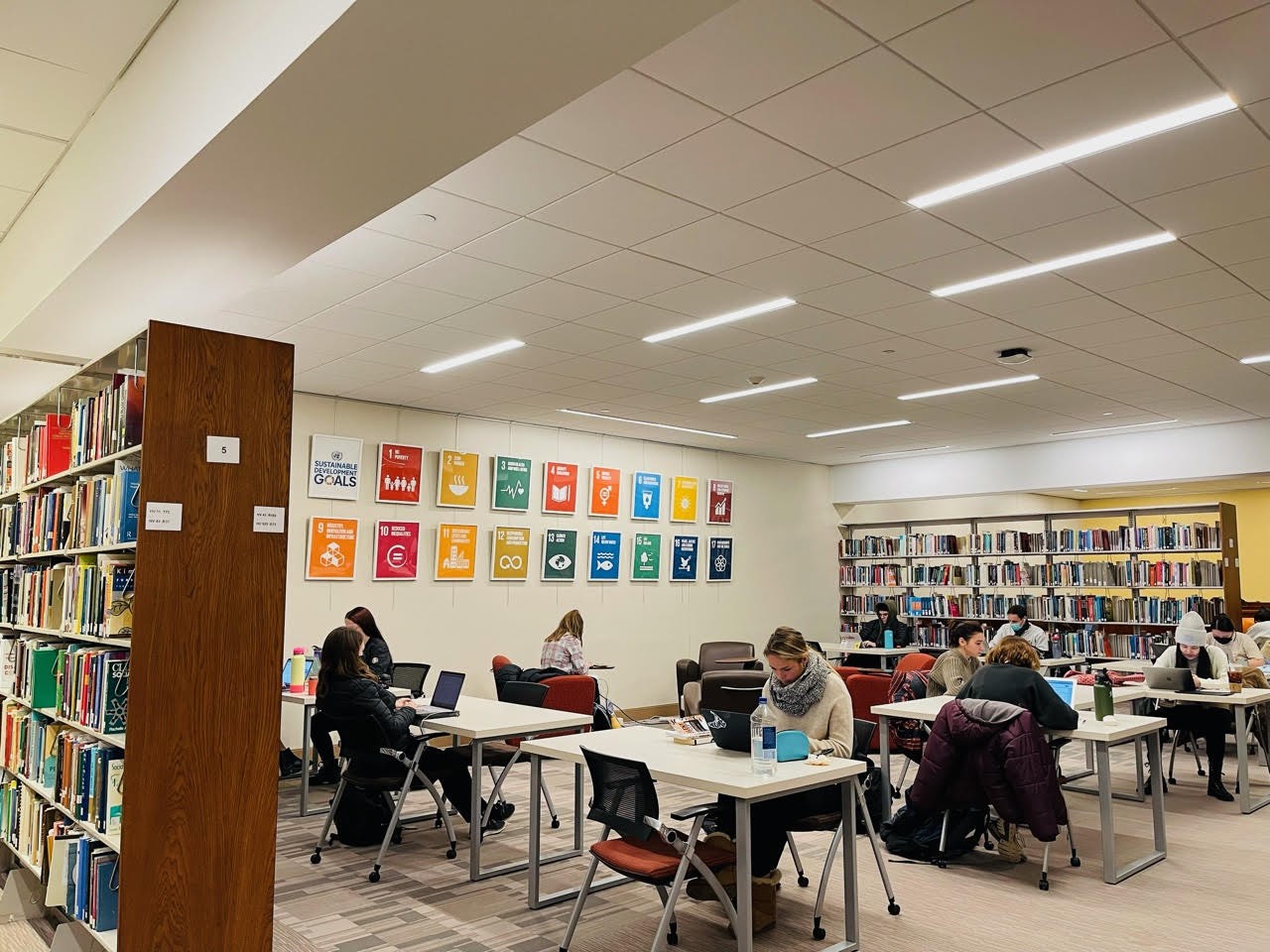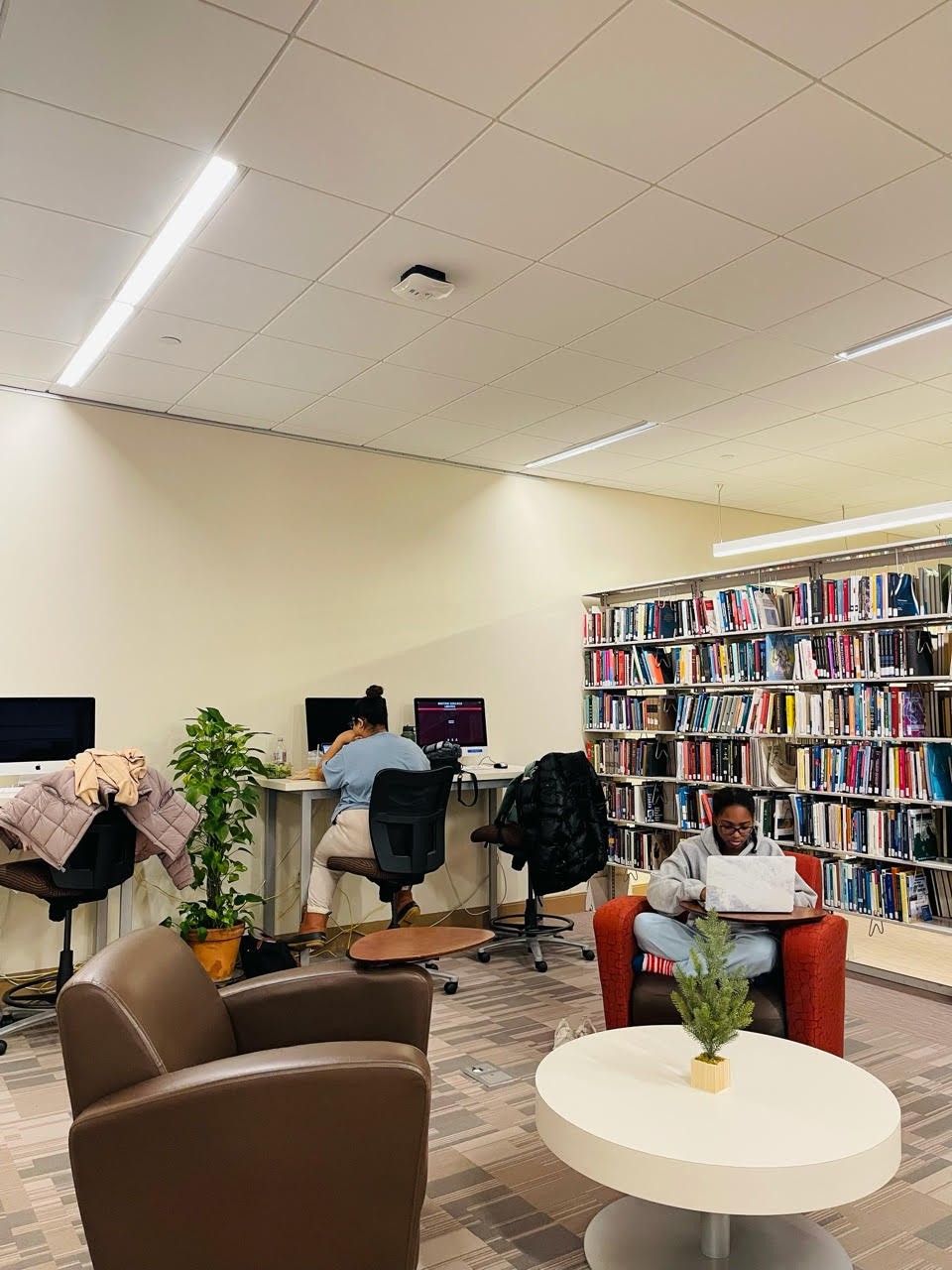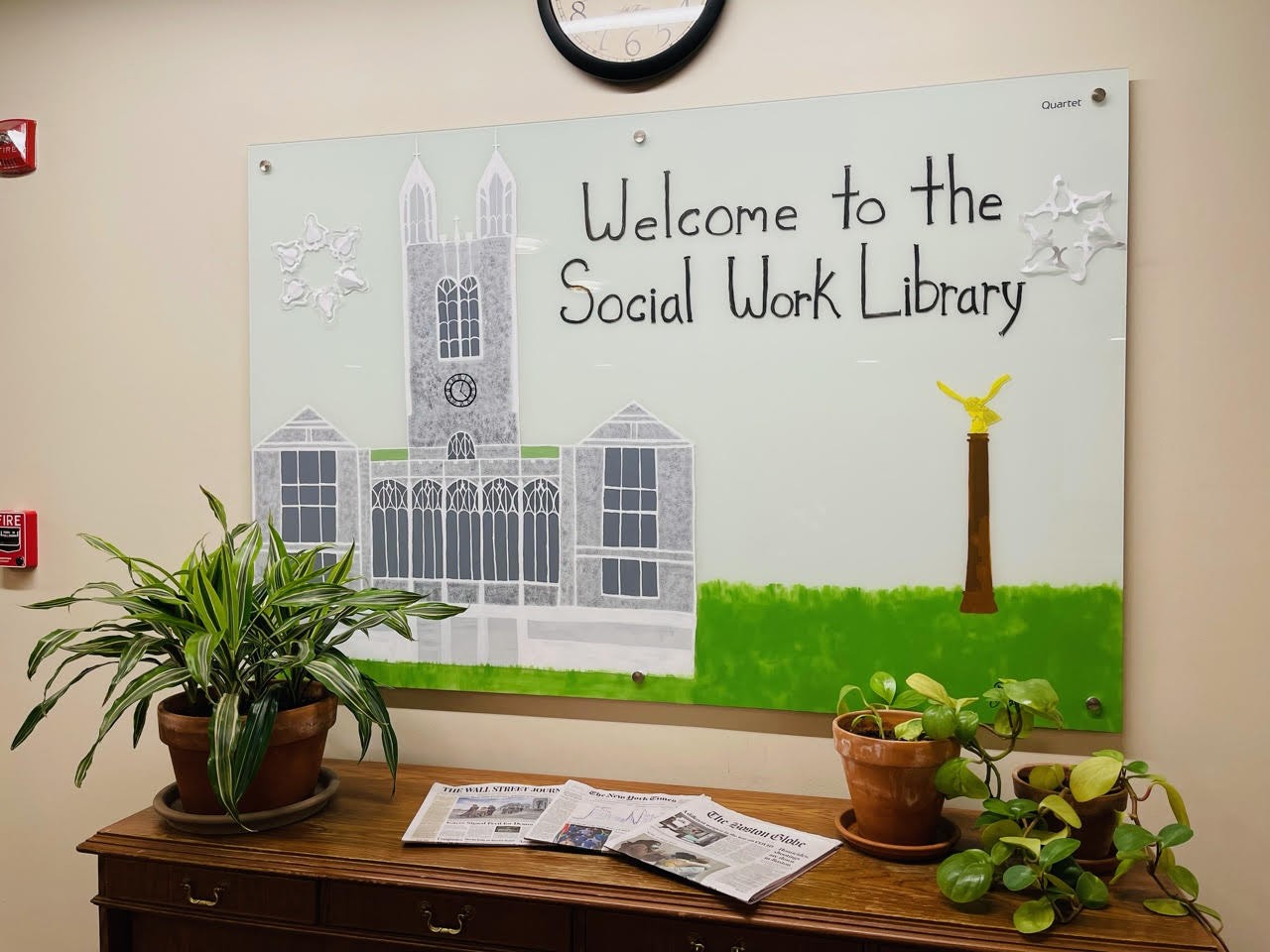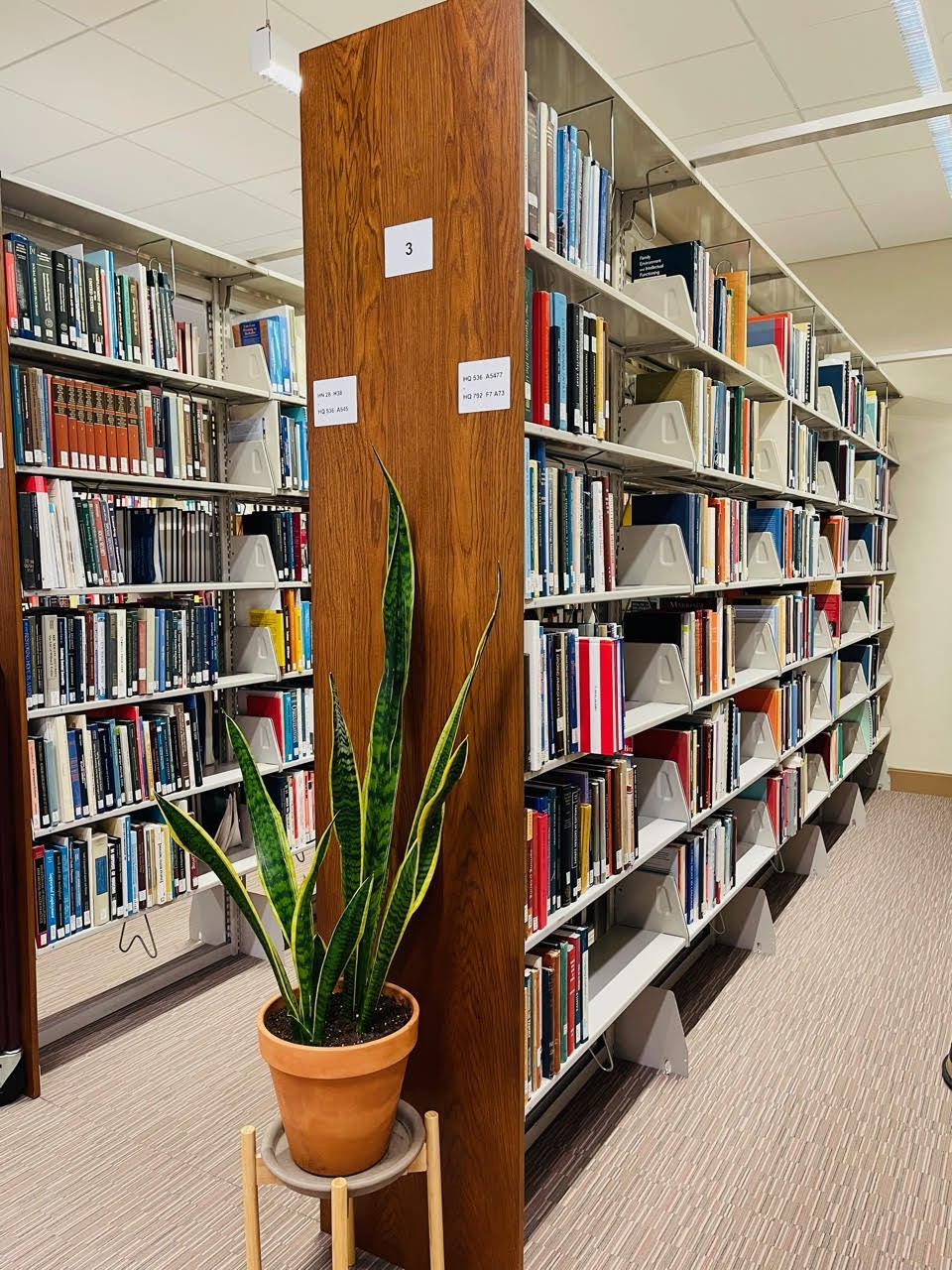
Students prepare for finals in the Social Work Library. Photos by Ana Sofía García Collazo, MSW'23.
At the start of the fall semester, the Social Work Library hosted an art exhibit that aimed to destigmatize people living with dementia. The exhibit featured portraits of 28 adults with the condition, alongside essays about their lives and photos of the subjects at a younger age.
“We like to complement whatever is happening in the School of Social Work,” says Hannah Ha, the head librarian. “We know that we have faculty who are focused on older adults, so that’s how we made the decision to bring the exhibit here.”
“The Day After Yesterday: Portraits of Dementia” marked the latest exhibit that the Social Work Library has hosted. But it was far from the first time the library has refused to say “shhh” to important issues. In 2018, for example, the library hosted a photography exhibit that depicted the plight of men, women, and children who had been trafficked across the world. Each image was paired with a plaque inscribed with a quote that brought the scourge of forced labor into stark relief. One piece of art, “The Price for Freedom,” depicted wads of Euros and featured a quote from a Nigerian woman trafficked to Italy. “This is what 50,000 Euros looks like,” she said. “This is my so-called debt, what my trafficker says I owe him.”
Exhibits like these represent one half of the library’s dual mission: to supplement the school’s aim to solve pressing social problems and to connect the BC community to resources needed to teach, learn, and conduct research. The library, the only one of its kind in New England, provides access to 20,000 books, e-books, databases, and major journals.

From left to right: Inaara Mohammed, MSW ’23, and Corinthia Paylor, MSW ’23.
In the stacks, which line the space in the basement of McGuinn Hall, you will find books on social work, psychology, and psychiatry. The New Jim Crow: Mass Incarceration in the Age of Colorblindness is one of the most read books in the print collection, according to Ha.
She says students in the School of Social Work can sign out physical copies of required books that are not available online or borrow laptops for up to two weeks. They can reserve one of two group study rooms, which come equipped with TV screens and phone charging stations.
“Sometimes social work students need time and space to study by themselves, and other times they thrive by sharing with each other,” she says. “They have space for both types of learning in the Social Work Library.”
The vibe of the library, which was renovated in 2015, belies its efforts to bring attention to hot button issues like human trafficking. On Wednesday, Dec. 15, two days before the end of the fall semester, it’s virtually silent.
Two students sit across from each other at a long, rectangular table, speaking in hushed tones as they prepare for a final exam. No one else says a word.
It is so quiet that you can hear one student tapping the keys on his laptop from 20 feet away. Another student, perched in a booth, studies her notes.
The gentle whir of an air purifier is calming, providing balm for the anxiety of crunch time.
“Students tend to stay quiet and we tend to give off that vibe,” Ha says during a private tour of the library. “Social work is a serious field, and that’s the image we want to project.”

A painting of Gasson Hall paired with the phrase “Welcome to the Social Work Library” greets students, faculty, and staff near the entrance to the space.
The library, she says, is a popular spot on campus for social work students to hang out and study. First-year student Clarabelle Valcin says she visits the library every day she is on campus, reserving group study rooms to work with her peers. As she puts it, “Once I figured out how to reserve the rooms, I knew this was where I would spend most of my semester.”
The library is conveniently located, she says, just downstairs from the social work lounge and near all of her classes. And she recently started checking out required books for her courses, too, saying “it’s helpful, because I do not have to bring my textbooks from home.”
Samuel Bradley, Jr., an assistant professor, says Ha helped him search for, reserve, and purchase books for several courses. One time, he says, Ha found him a copy of Human Services and the Afrocentric Paradigm, a book that presents a new way to understand human behavior and attack social problems.
“She has consistently let me know about resources that she has found to be interesting and helped me to uncover materials,” says Bradley.
Ha knows that faculty like Bradley are busy teaching and conducting research. They often don’t have time to go on a wild goose chase for a journal article or text book. That’s where she and her full time colleagues—Day Library Supervisor Abby Heingartner and Reference and Instruction Librarian Adam Williams—come in.
“We are convenient for them and take service very seriously,” says Ha. “If we don’t know the answer, rather than redirecting them to somewhere else, we find the answer for them. They know that we are their one-stop place for any questions related to the library.”

The library connects students, faculty, and staff to 20,000 books, e-books, databases, and major journals.
If you visit the library, the first thing you will see is the service desk. It is low, curved, and, says Ha, “gives an inviting impression.” On the opposite wall, you will see a painting of Gasson Hall paired with the phrase “Welcome to the Social Work Library.” Walk further into the space, and you will come across the library’s permanent art exhibition: printed and framed graphics that depict each of the 17 Sustainable Development Goals set by the United Nations to ensure peace and prosperity for people and the planet.
In the spring semester, this installation will be replaced by a special exhibit that highlights the contributions that African Americans made to social work during the Progressive Era. “Lifting As We Climb” will shine a light on 14 pioneers from the 1890s to 1940s whose accomplishments include the founding of the National Urban League and the National Association of Colored Women. Detailed biographies will accompany portraits of each pioneer, whose contributions to the field have often been overlooked.
“When we talk about social welfare pioneers, we talk about Jane Addams, Eleanor Roosevelt, maybe even Mother Teresa, but Black social work pioneers don’t really get mentioned,” says Ha. “So we’re going to have a permanent display of Black social welfare pioneers.”
Bradley, who co-founded the Black Leadership Initiative in the school, looks forward to seeing the exhibit. “Librarians hold a powerful space in education because so many students gather in libraries,” he says. “They have the ability to create conditions under which students are studying but also able to be inspired by things they may not have come across before.”


